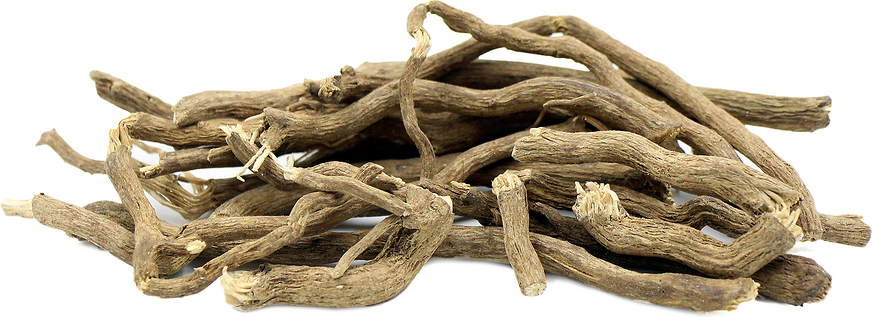


Kava Roots
Estimated Inventory, lb : 0
Description/Taste
Kava roots are irregularly shaped, cylindrical, and begin wide and taper into slender, smaller roots, widely varying in length with the ability to grow over one meter. The root has two distinct sections known as the crown root, which is a thick, block-like mass near the base of the plant and the lateral root which is much smaller and slender, often clustering and resembling a common tree root. Lateral roots have the highest concentration of the plant’s active compounds and are the most desired portion. They have rough, brown, bark-like skin, and a cross-section of fresh Kava root reveals a yellow, dense flesh with a pinwheel pattern around a central core. Kava root has a pungent smell and a taste that is often considered bitter and earthy.
Seasons/Availability
Kava root is available year-round in tropical regions.
Current Facts
Kava, botanically classified as Piper methysticum, is the underground root of a tropical shrub and is a member of the Piperaceae or black pepper family. Used as a customary social drink in the island nations of the South Pacific, Kava is known for being crushed and juiced into a beverage nicknamed the “drink of peace,” which is a drink with relaxing and sedative qualities. There are over two hundred different varieties of Kava root in tropical regions around the world, with only twelve varieties considered safe for commercial consumption. The benefits of Kava root reached global notoriety at the end of the 1990s and in the early 2000s when Kava became popular as an anti-anxiety supplement supporting relaxation. Incorrect use of Kava root resulted in a temporary ban of Kava root products by several countries after liver toxicity issues arose. This was likely the result of improper extraction methods combined with the use of highly potent and potentially toxic Kava cultivars, such as wild kava or tu’dei. Since then, stringent growing and selling practices have standardized the market for Kava root and have identified preferred strains for exportation and consumption.
Nutritional Value
Kava root contains small amounts of alkaloids and flavonoids, which are antioxidants to help protect the overall health of the body. The root also contains active compounds known as kavalactones, which have effects similar to a sedative. Ingesting Kava root does not impair motor skills or cognitive abilities like alcohol, but it is metabolized by the liver, and when combined in high doses with other prescription sedatives or alcohol, it can lead to liver hypertoxicity and even liver failure. Those with liver disease and pregnant women are not advised to consume Kava root, and the root should be discussed with a health care professional before ingesting.
Applications
When fresh, Kava roots can be cut into small pieces and chewed, or the roots can be dried and ground into a powder. A beverage can be made from either the fresh or dried root using cold water, milk, or a milk substitute, but generally, liquids containing fats like cow, goat, or coconut milk are preferred for extracting the most of Kava’s active constituents. The beneficial compounds in Kava root are destroyed if heated above 140 degrees Fahrenheit, so traditional methods of extraction require cool liquids. There are two primary methods for making Kava tea with one technique utilizing a “dunking cloth” method, where the ground root is measured into a muslin cloth or bag, and then liquid is poured over the bag into a bowl, dunking it repeatedly in the liquid to agitate. The concoction is then left to steep and is consumed. Another method is blending the root with water, steeping, and then blending again with a few tablespoons of milk, fruit juice, ginger, or other sweeteners like honey. The liquid is poured into a muslin bag, and the solids are squeezed to release any remaining liquid. It is also important to note that the steeped concoction made from the root will cause slight numbing or tingling sensations in the mouth and on the tongue. Store fresh Kava roots in the refrigerator, lightly wrapped in plastic, for up to a week. Dried Kava root will store up to six months in an airtight container.
Ethnic/Cultural Info
Used for religious, social, and ceremonial purposes in Polynesia, Fiji, and Hawaii, Kava root has been prepared the same way for over three thousand years. The root is revered in Vanuatu and the Samoan islands and was traditionally used by chiefs and priests. Today, Kava can be found at local Kava bars known as nakamals. At these bars, Kava root tea is traditionally served in a wooden bowl, made from local wood called a tanoa fa'iva. This type of ceremonial serving bowl has been used in Fiji and Samoa for thousands of years. In some locations, Kava root is crushed and ground by hand using a cone-shaped, dried block of coral.
Geography/History
Kava is native to several islands in Polynesia, which is an area that makes up most of the Central and South Pacific islands. The plant thrives in partial sun, shaded from the canopy of the tropical forests and prefers humid, warm climates. Today Kava root is still grown on the tropical islands of the South Pacific, especially on Vanuatu and Fiji, and is available at fresh local markets also in Hawaii, Papua New Guinea, Micronesia, Samoa, and Tonga.




